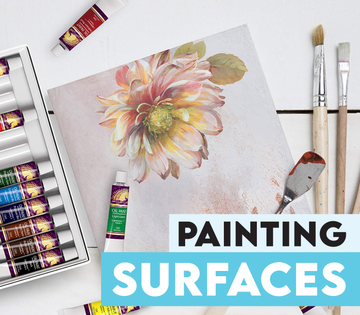With any painting, you’re going to want a good surface to paint on. For each type of paint, there are a few options to choose from, depending on your preference.
From watercolor papers, to stretched canvases, there is always an option for everyone.
Watercolor Paper

When you plan painting with media that may need a lot of water, like watercolor and gouache, you’ll want something that can handle the water.
Watercolor paper is specifically designed to work well with both watercolor and gouache. When picking out a watercolor paper, you don’t want paper that’s too thin. Usually, any watercolor paper labeled 140lb (300 gsm) is a great start.
You could even get a heavier paper if you wish. You want to make sure that the paper is meant for water-based media, because even if the paper is heavy enough, if it isn’t designed for water, it won’t be coated. Non-coated papers will warp badly and peel with water.
Along with paper weight, another thing to consider is the paper texture. Most watercolor papers come in hot press and cold press, some occasionally come in rough.
Hot pressed watercolor paper has a very smooth texture, whereas cold pressed has a rough, toothy texture. Rough paper is just like cold pressed, but with more texture to it. However, texture is really the only difference, so feel free to experiment with which one you like most.
Another thing to consider is what the paper is made of. Most watercolor papers are made with a mixture of wood pulp and other cellulose fibers. Higher quality papers are made with 100% cotton, and are more expensive. These higher quality papers can also take a lot more lifting, scrubbing, etc., than the lower quality papers.
Canvas and Panels

If you’re painting with thicker paints, like acrylic and oils, you will want a sturdy surface that can handle them. For that, you will want a canvas of some type.
There are a few types of canvases: One is stretched canvases, which are canvases stretched over wooden bars, you can buy these pre-stretched, or you can stretch your own.
Another is canvas panels, which are canvases mounted to a solid board.
Lastly, there are also canvas pads, which are pads of paper, meant to mimic canvas texture. Canvas pads are great for beginners, or for practice.
Canvas can also come in different textures, depending on how it’s woven. The finer it’s woven together, the smoother the texture. If you prefer smooth, detailed strokes, you’ll want a very finely woven canvas. If you want bold, textured strokes, you may prefer a rough texture.
Another thing to consider is cost. There are two types of canvas: linen and cotton. Linen is the top of the line, and is expensive. Cotton, while lower in quality, is affordable and more than suitable for long lasting paintings.
Each canvas can come primed or unprimed. For oils, you’ll always want to either find a pre-primed canvas, or prime your own with gesso. Acrylics can be painted onto an unprimed canvas, but the colors will be duller, than on a canvas that is primed with gesso. Gesso makes sure that the paint will adhere properly to the
canvas.
You’ll want a good surface that can handle whatever medium you throw at it. Try a few different types of canvases, or papers, and see which one suits your painting style the best!
Article by McCaela Gates
Made especially for MyArtscape



